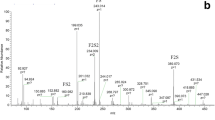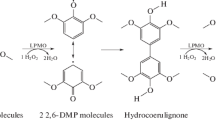Abstract
A study was made of polysaccharides and glycosphingolipids isolated from Aspergillus fumigatus grown in media supplemented with human serum from healthy donors. Fractionation of Cetavlon-precipitated polysaccharides on Sephacryl S-400 gave rise to an excluded fraction (Fraction I) with molecular weight of >400 kDa and an included peak (Fraction II) with an average molecular weight of 30–80 kDa. Fraction I comprises about 5% of total polysaccharide and was identified as a glycogen-like molecule. Its structure was deduced from methylation data, treatment with amyloglucosidase, a red-brown coloration produced with an iodine solution and by 1H and 13C-NMR spectroscopy. It was previously suggested that higher amounts of glycogen-like polysaccharide (20%) were present in A. fumigatus grown in serum-free medium. Fraction II was identified as a galactomannan and was the main polysaccharide of A. fumigatus grown in serum-supplemented medium. Its structure was elucidated mainly by 13C-NMR spectroscopy combined with partial acetolysis and methylation analysis. The 13C-NMR spectrum of the galactomannan showed a much greater complexity in the β-d-galf and α-d-manp C-1 regions, than was evident for galactomannan from serum-free cultures previously described, reflecting differences in the glycosylation pattern, stimulated in serum-supplemented medium.
No differences in A. fumigatus glycosphingolipid could be detected between serum-containing and serum-free growth conditions.
Our results demonstrate that the change in polysaccharide structure is a more specific response to the altered growth conditions and not merely a symptom of more general changes.
Similar content being viewed by others
References
Barreto Bergter E. Chemical structure, immunology and application of polysaccharides of fungi and lichens. In: Atta-ur-Rahman (ed.) Studies in Natural Products Chemistry, Vol 5, New York; Elsevier, 1989, pp. 275-340.
Hearn VM. Antigenicity of Aspergillusspecies. J Med Vet Mycol 1992; 30: 11-25.
Barreto Bergter E, Gorin PAJ, Travassos LR. Cell constituents of mycelia and conidia of Aspergillus fumigatus. Carbohydr Res 1981; 95: 205-218.
Fratamico PM, Buckley HR. Identification and characterization of an immunodominant 58-kilodalton antigen of Aspergillus fumigatusrecognized by sera of patients with invasive aspergillosis. Infect Immun 1991; 9: 309-315.
Ste-Marie L, Sénéchel S, Boushira M, Garzon S, Strykowski LP, Repentigny L. Production and characterization of monoclonal antibodies to cell wall antigens ofAspergillus fumigatus. Infect Immun 1990; 58: 2105-2114.
Bennett JE, Bhattacharjee AK, Glaudemans CPJ. Galactofuranosyl groups are immunodominant in Aspergillus fumigatusgalactomannan. Mol Immunol 1985; 22: 251-254.
Reiss E, Lehman PF. Galactomannan antigenemia in invasive aspergillosis. Infect Immun 1979; 25: 357-365.
Barreto Bergter E, Travassos LR, and Gorin PAJ. Chemical structure of the D-galacto-D-mannan component from hyphae of Aspergillus nigerand other Aspergillusspp. Carbohydr Res 1980; 86: 273-285.
Latgé JP, Kobayashi H, Debeaupuis JP, Diaquin M, Sarfati J, Wieruszeski JM, Parra E, Bouchara JP and Fournet B. Chemical and immunological characterization of the extracellular galactomannan of Aspergillus fumigatus. Infect Immun 1994; 62: 5424-5433.
Müthing J, Pörtner A, Jäger V. Ganglioside alterations of YAC-1 cells cultivated in serum-supplemented and serum-free growth medium. Glycoconjugate J 1992; 9: 265-273.
Villas Boas, MHS, Egge H, Pohlentz G, Hartmann R, Barreto Bergter E. Structural determination of N-2′-hydroxyoctadecenoyl-1-O-β-D-glucopyranosyl-9-methyl-4,8-sphingadienine from species of Aspergillus. Chem Phys Lipids 1994; 70: 11-19.
Lloyd, KO. Isolation, characterization and partial structure of peptidogalactomannans from the yeast form of Cladosporium werneckii. Biochemistry 1970; 9: 3446-3453.
Dubois M, Gilles KA, Hamilton JK, Reber PA, Smith E. Colorimetric method for determination of sugar and related substances. Anal Chem 1956; 28: 350-356.
Lowry OH, Rosebrough NJ, Farr AL, Randall RJ. Protein measurement with the Folin phenol reagent. J Biol Chem 1951; 193: 265-275.
Ames, BN. Assay of inorganic phosphate, total phosphate and phosphatase. Meth Enzymol 1966; 8: 115-118.
Belcher RA, Nutten AJ, Sambrook CM. The determination of glucosamine. Analyst 1954; 7: 201-208.
Sawardeker JS, Sloneker JH, Jeanes A. Quantitative determination of monosaccharides as their alditol acetates by gas-liquid chromatography. Anal Chem 1965; 20: 41-50.
Ciucanu J, Kerek F. A simple and rapid method for the permethylation of carbohydrates. Carbohydr Res 1984; 131: 209-217.
Lee YC, BalIou CE. Preparation of mannobiose, mannotriose and a new mannotetraose. Biochemistry 1965; 4: 257-264.
Krisman CR. A method for the colorimetric estimation of glycogen with iodine. Anal Biochem 1962; 4: 17-23.
Becker JU. A method for glycogen determination in whole yeast cells. Anal Biochem 1978; 86: 56-64.
Egge H, Katalinik JP. Fast atom bombardinent mass spectrometry for structural elucidation of glycoconjugates. Mass Spectrom Rev 1987; 6: 331-393.
Zierer MS, Vieira RP, Mulloy B, Mourão PAS. A novel acidic glycogen extracted from the marine sponge Aplysina fulva. Carbohydr Res 1995; 274: 233-244.
Zang LH, Howseman AM, Shulman RG. Assignment of the 1H chemical shifts of glycogen. Carbohydr Res 1991; 220: 1-9.
Gorin, PAJ, Barreto Bergter E, Cruz FS. The chemical structure of the D-galacto-D-mannan component of Trypanosoma cruzi: 13C-NMR shift dependence on structure of D-galactose to Dmannose linkage. Carbohydr Res 1981; 88: 177-188.
Gorin PAJ. Rationalization of carbon-13 magnefic resonance spectra of yeast and structurally related oligosaccharides. Can J Chem 1973; 51: 2375-2383.
Barreto Bergter E, Gorin PAJ. Structural chemistry of polysaccharides from fungi and lichens. Adv Carbohydr Chem Biochem 1983; 41: 67-103.
Author information
Authors and Affiliations
Rights and permissions
About this article
Cite this article
da Silva Bahia, M.C.F., Vieira, R.P., Mulloy, B. et al. The structures of polysaccharides and glycolipids of Aspergillus fumigatus grown in the presence of human serum. Mycopathologia 137, 17–25 (1997). https://doi.org/10.1023/A:1006862420963
Issue Date:
DOI: https://doi.org/10.1023/A:1006862420963




